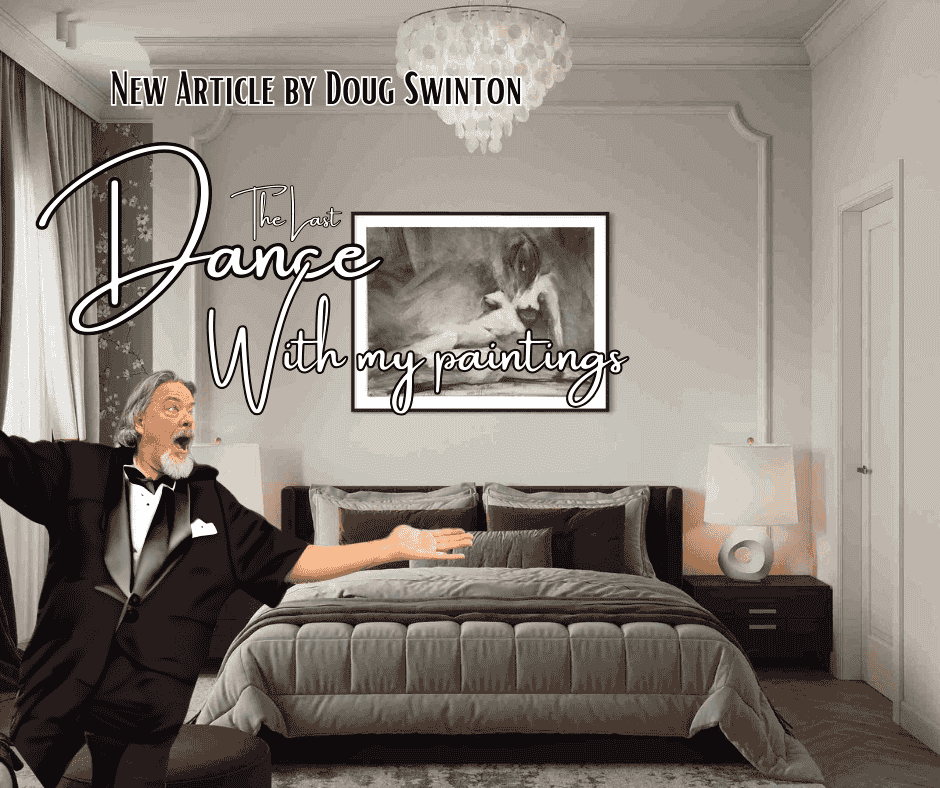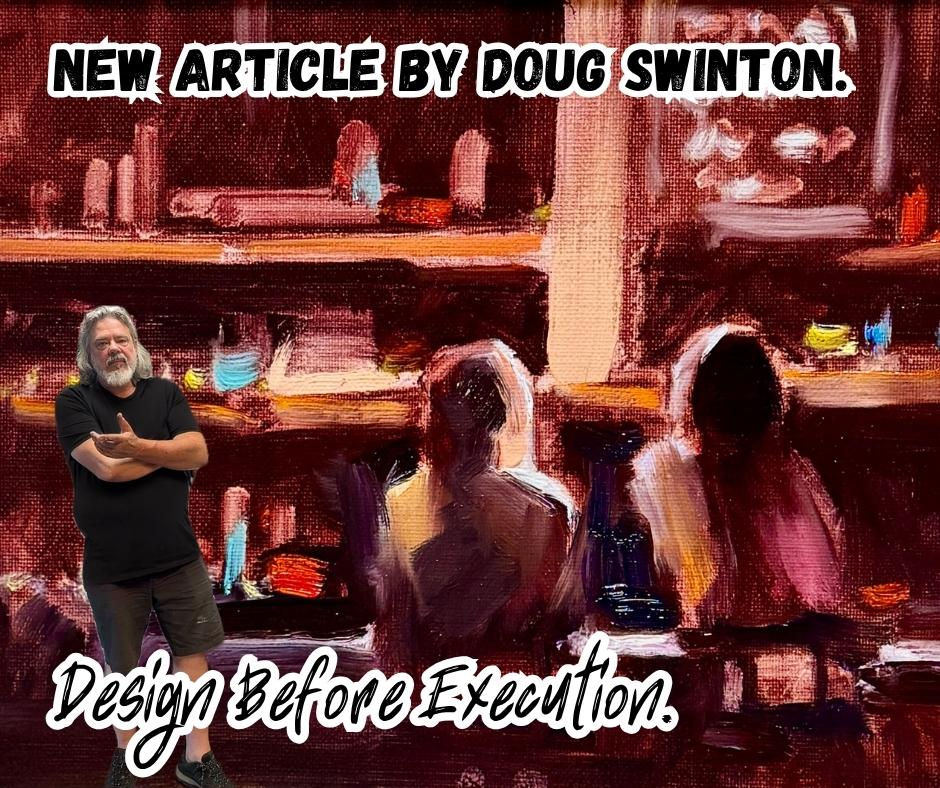7 Ways To Give Your Painting Dimension
- Doug Swinton

- Apr 9, 2019
- 3 min read
Updated: Feb 22
Value, Temperature, Chroma, Perspective, Texture...

It is important to be able to translate what you see in three dimensions onto a two-dimensional surface and to convincingly evoke a sense of depth and space. Learning how to create different spatial effects can make your paintings stronger and more interesting. You don’t want your landscape painting to look flat. Use the following technique to create paintings that appear to have distance and depth and make your landscape or still-life more convincing.
You can use one or a combination of these techniques to lead the viewer's eye into the scene.
1: Value
Items that are nearer to the picture plane have a higher degree of value range (the lights and dark difference). As the distance recedes the values will get closer and more narrow. Trees in the front of the picture may use a value range from 2 to 8 but trees nearer the horizon line, well into the picture plane, may have a range of only 5 to 7. Objects like rocks and trees or clouds get closer in value as they recede having less and less contrast.

Painting by Matt Smith WEBSITE
2: Temperature
Warm tones come forward and cool tones recede. Colours cool significantly as they move back into the picture plane. Notice how all the warms are near the front of this David Santillanes (FACEBOOK) painting.

3: Chroma
Bright colours come forward and dull colours recede. If you want something to look like it’s in the distance, not only do you need to cool it off but you must also make it duller.
In this Jill Carver (WEBSITE) painting all the brightest colours are in the front of the canvas and as you recede the colours get much more muted. This is a good reason to have a puddle of grey always working for you on your palette.

4: Linear Perspective
The more vertical a line is, the more it comes forward. The more horizontal a line is, the more it tends to recede. Angles get more acute as they near the bottom of the canvas and get more horizontal as they recede into the plane of the picture.
The subtle “s” curve is another way to use this method.

Painting by Scott ChristensenWEBSITE
5: The Big 3 Shape Changers
Overlapping shapes, size and layering are 3 other methods that can be used to achieve depth. These can be used alone or in conjunction with each other in placement.
Objects should look bigger as they get near to you and smaller as they recede.
Overlapping objects will air in recession as well. Proper placement of objects helps.
Notice how cloud “c” seems larger than cloud “a”. The optical illusion here is because things closer to eye level should be smaller in size. By combining size and placement you get a stronger sense of recession.

6: Foreground Interest
Sticking some big stuff in the foreground of the painting can do wonders for creating the illusion of distance. Have a look at this John Carlson painting (Yes - the same John Carlson that wrote the book you should re-read. You do have Carlson’s Guide to Landscape Painting don’t you?)

7: Detail and Texture
Objects have more detail the closer they are and less as they recede. Also, thick paint tends to come forward and thin paint tends to recede. This all needs to be held into context if you’re using it to enhance your centre of interest.
Although it's hard to tell from a photograph, this Ted Goerschner painting has all the thicker paint applied to the teapot and the fruit in the front of the painting. The flowers and vase have a thinner application.

In this world-class painting by some unknown dude from Calgary (WEBSITE), he has used a combination of techniques.
Cooler colours in the back and warmer colours in the front.
A slight “s” curve to lead you in.
Overlapping trees.
Again, hard to tell from a photograph, but the paint in the snow has been applied with a heavier application, while the trees are thinner and the hill in the back is thinner yet. (I know, because I know the guy who painted it.)

That's all for now kiddies. Keep those brushes swinging!
Your friend in art,
Doug.








I remember reading through a long discussion thread online where people were sharing different thoughts without a clear direction. In the middle of the conversation, someone dropped the link https://phsky.onl/ while continuing their comment. I kept reading the rest of the discussion as it moved on, without focusing on that detail, and then scrolled past to other replies.
Mình có lần lướt đọc mấy bình luận trao đổi trên mạng thì thấy có người nhắc tới Dangtesttrong lúc câu chuyện đang nói dở. Mình mở ra xem qua trong thời gian ngắn, chủ yếu là nhìn cách nội dung được sắp xếp và trình bày tổng thể. Đọc lướt một vòng rồi mình quay lại theo dõi tiếp các bình luận khác, chứ cũng không để ý thêm.
Mình có lần lướt đọc mấy chia sẻ trên mạng thì thấy có người nhắc tới app tài xỉu, nên cũng tò mò mở ra xem thử cho biết. Mình chỉ xem qua trong thời gian ngắn thôi, chủ yếu để nhìn giao diện và cách bố trí tổng thể, cảm giác khá gọn gàng và dễ theo dõi, không bị rối mắt khi xem nhanh.
Có thời gian rảnh mình hay xem qua mấy nội dung giải trí cho đỡ căng thẳng, trong lúc đó có thấy nhắc tới nohu nên mình cũng tìm hiểu thử cho biết. Mình không vào với mục đích gì cụ thể, chỉ xem qua cách họ trình bày thông tin và bố cục tổng thể. Cảm nhận ban đầu là mọi thứ sắp xếp khá gọn, nhìn không bị rối mắt, đọc lướt cũng dễ hiểu. Với mình thì xem như vậy là đủ để nắm khái quát, không cần phải đào sâu thêm.
Thường thì trước giờ bóng lăn mình có thói quen đọc vài bài kèo cho đủ góc nhìn, mỗi trang một kiểu viết. Trong một bài như vậy, phần nội dung có đề cập đến Kèo nhà cái như một cơ sở để phân tích trận đấu. Mình đọc liền một mạch, chủ yếu để hiểu cách họ sắp xếp thông tin, chứ cũng không dừng lại quá lâu ở chi tiết nào.